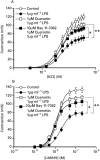Quercetin and its principal metabolites, but not myricetin, oppose lipopolysaccharide-induced hyporesponsiveness of the porcine isolated coronary artery
- PMID: 21375526
- PMCID: PMC3057287
- DOI: 10.1111/j.1476-5381.2010.00919.x
Quercetin and its principal metabolites, but not myricetin, oppose lipopolysaccharide-induced hyporesponsiveness of the porcine isolated coronary artery
Abstract
Background and purpose: Quercetin is anti-inflammatory in macrophages by inhibiting lipopolysaccharide (LPS)-mediated increases in cytokine and nitric oxide production but there is little information regarding the corresponding effect on the vasculature. We have examined the effect of quercetin, and its principal human metabolites, on inflammatory changes in the porcine isolated coronary artery.
Experimental approach: Porcine coronary artery segments were incubated overnight at 37°C in modified Krebs-Henseleit solution with or without 1µg·mL(-1) LPS. Some segments were also co-incubated with quercetin-related flavonoids or Bay 11-7082, an inhibitor of NFκB. Changes in isometric tension of segments to vasoconstrictor and vasodilator agents were recorded. Nitrite content of the incubation solution was estimated using the Griess reaction, while inducible nitric oxide synthase was identified immunohistochemically.
Key results: Lipopolysaccharide reduced, by 35-50%, maximal contractions to KCl and U46619, thromboxane A(2) receptor agonist, and impaired endothelium-dependent relaxations to substance P. Nitrite content of the incubation medium increased 3- to 10-fold following exposure to LPS and inducible nitric oxide synthase was detected in the adventitia. Quercetin (0.1-10µM) opposed LPS-induced changes in vascular responses, nitrite production and expression of inducible nitric oxide synthase. Similarly, 10µM Bay 11-7082, 10µM quercetin 3'-sulphate and 10µM quercetin 3-glucuronide prevented LPS-induced changes, while myricetin (10µM) was inactive. Myricetin (10µM) prevented quercetin-induced modulation of LPS-mediated nitrite production.
Conclusion and implications: Quercetin, quercetin 3'-suphate and quercetin 3-glucuronide, exerted anti-inflammatory effects on the vasculature, possibly through a mechanism involving inhibition of NFκB. Myricetin-induced antagonism of the effect of anti-inflammatory action of quercetin merits further investigation.
© 2011 The Authors. British Journal of Pharmacology © 2011 The British Pharmacological Society.
Figures







References
-
- Blonska M, Czuba ZP, Krol W. Effects of flavone derivatives on interleukin-1β (IL-1β) mRNA expression and IL-1β protein synthesis in stimulated RAW 264.7 macrophages. Scand J Immunol. 2003;57:162–166. - PubMed
-
- Boots AW, Haenen GRMM, Bast A. Health effects of quercetin: from antioxidant and nutraceutical. Eur J Pharmacol. 2008;585:325–337. - PubMed
-
- Chen Y, Shen S, Lee W, Hou W, Yang L, Lee F. Inhibition of nitric oxide synthase inhibitors and lipopolysaccharides induced inducible NOS and cyclo-oxygenase-2 gene expressions by rutin, quercetin, and quercetin pentaacetate in RAW 264.7 macrophages. J Cell Biochem. 2001;28:537–548. - PubMed
-
- Chen J, Feng-Ming F, Chao P, Chen C, Jeng K, Hsu H, et al. Inhibition of iNOS gene expression by quercetin is mediated by inhibition of Ik B kinase, nuclear factor-kappa B and STAT1 and depends on heme oxygenase-1 induction in mouse BV-2 microglia. Eur J Pharmacol. 2005;521:9–20. - PubMed
-
- Edwards R, Lyon T, Litwin E, Rabovesky A, Jalili T. Quercetin reduces blood pressure in hypertensive subjects. J Nutr. 2007;137:2405–2411. - PubMed
Publication types
MeSH terms
Substances
Grants and funding
LinkOut - more resources
Full Text Sources

